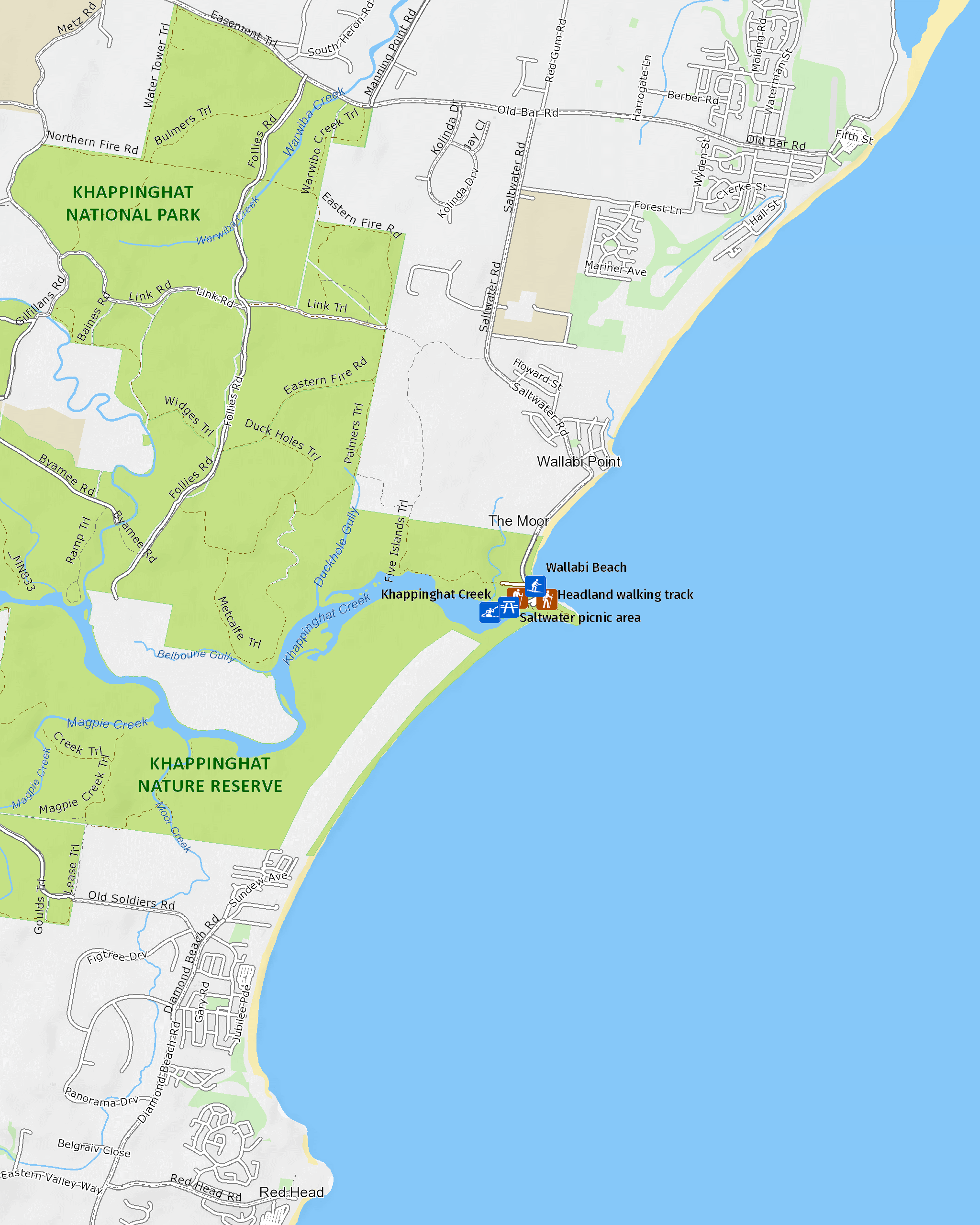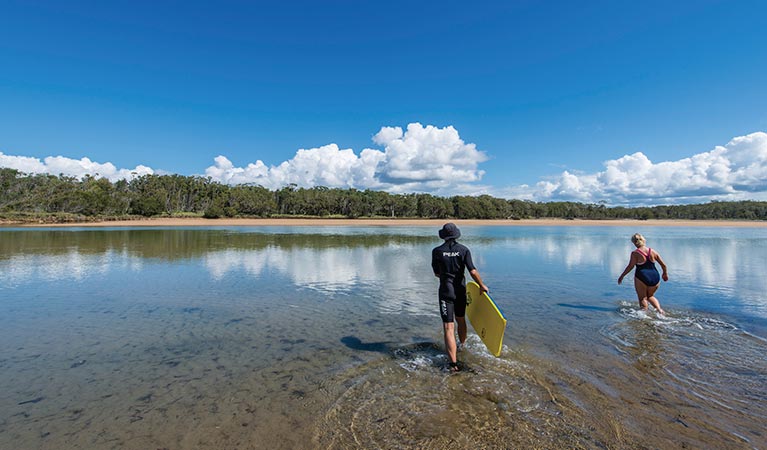Overview
At the flat water Khappinghat Creek, kayak or canoe through undeveloped wetlands, mangroves and rainforest. Swimming and fishing near Taree on the mid-north coast of NSW.
- Where
- Saltwater National Park in North Coast
- What to
bring - Hat, sunscreen, drinking water
Enjoy flatwater kayaking or canoeing in a lovely, tranquil estuary setting at Khappinghat Creek. Seeing rainforest, mangroves, salt flats, and sedge and rush-dominated, undeveloped wetlands from your kayak is a completely immersive experience.
The estuary is one of only a few naturally opening and closing estuarine systems on the mid-north coast of NSW, making it a terrific, low-impact way to explore this gorgeous area.
The creek is popular with flat-water canoeists and kayakers all year round. Birdwatching from your canoe means you can glide past without making a sound, so come equipped with your binoculars to spot white-breasted sea eagles, ospreys and brehminy kites. When you're finished, enjoy a picnic at Saltwater picnic area or take a walk along Five Islands walking track.
Map

Map legend

Local alerts
For the latest updates on fires, closures and other alerts in this area, see https://www.nationalparks.nsw.gov.au/things-to-do/canoeing-paddling-experiences/khappinghat-creek/local-alerts
Park info
- in Saltwater National Park in the North Coast region
Saltwater National Park is always open but may have to close at times due to fire danger.
Visitor info
All the practical information you need to know about Khappinghat Creek.
Getting there and parking
Khappinghat Creek in accessed from Saltwater picnic area in Saltwater National Park. To get there:
- Take Old Bar Road from Taree/Pacific Highway
- Drive 10km east and turn right onto Saltwater Road
- Follow Saltwater Road past the village of Wallabi Point
- Saltwater picnic area is at the end of Saltwater Road
Road quality
- Sealed roads
Vehicle access
- 2WD vehicles
Weather restrictions
- All weather
Parking
Parking is available at Saltwater picnic area.
Best times to visit
There are lots of great things waiting for you in Saltwater National Park. Here are some of the highlights.
Autumn
Take walks around the headland and through to adjoining Khappinghat Nature Reserve.
Spring
Enjoy whale watching from the viewing platform at Saltwater Point from August through November.
Summer
Swim, surf and sunbathe on the beaches, canoe and kayak in the creek, or enjoy a picnic on the grass under the shady rainforest trees.
Weather, temperature and rainfall
Summer temperature
Average
17°C and 29°C
Highest recorded
45.2°C
Winter temperature
Average
8°C and 21°C
Lowest recorded
-5°C
Rainfall
Wettest month
March
Driest month
August
The area’s highest recorded rainfall in one day
280.2mm
Facilities
Toilets
- Flush toilets
Boat ramp
Carpark
Maps and downloads
Permitted
Fishing
A current NSW recreational fishing licence is required when fishing in all waters.
Prohibited
Gathering firewood
Pets
Pets and domestic animals (other than certified assistance animals) are not permitted. Find out which regional parks allow dog walking and see the pets in parks policy for more information.
Smoking
NSW national parks are no smoking areas.
Learn more
Khappinghat Creek is in Saltwater National Park. Here are just some of the reasons why this park is special:
Spiritually significant landscape

Saltwater Beach and its surrounds are a cultural landscape of great importance to the local Aboriginal Biripi tribe. There are several sites related to the Dreamtime within the park, and the area is declared an Aboriginal Place. Joint management with Aboriginal people and local residents, in association with Saltwater Tribal Council and NPWS, gives this park special local importance.
- Five Islands walking track This gorgeous coastal walking track follows a part of the Saltwater National Park coastline that is rich in Aboriginal history with great spots for swimming, fishing, surfing, and sailing, near Taree.
- Saltwater picnic area Enjoy relaxed picnicking or barbecues at this well-equipped picnic area with ocean beaches and walking tracks nearby where you can swim, fish, surf, kayak or birdwatch.
Striking plant life

Parts of the park are listed as endangered ecological communities and there are a number of rare and lovely plant species to be spotted here. Keep your eyes out on the walking tracks for magenta lilly pilly, a small tree with dark shiny leaves, magenta-coloured fruit and white-flowered wax plant. Pink-flowering pinnate boronia, and the golden flowers of the wallum banksia, among others, can all be seen in Saltwater National Park. The park also supports many marine-dependant species, such as the white-bellied sea eagle, as well as endangered or vulnerable species including the pied oystercatcher, little tern, the flesh-footed shearwater and osprey.
- Headland walking track This short walk around the headland takes you to a whale watching viewing platform, has Aboriginal history, is near Khappinghat Nature Reserve near Taree.
Surf's up

Saltwater Beach's headland is a highly popular surfing point break used for recreational surfing, as well as club and competition surf events. Take a stroll through a rainforest walking track, and be sure to do a spot of whale watching at Saltwater Point. The adjacent Saltwater Beach and Wallabi Beach are popular surfing and swimming areas.
- Khappinghat Creek At the flat water Khappinghat Creek, kayak or canoe through undeveloped wetlands, mangroves and rainforest. Swimming and fishing near Taree on the mid-north coast of NSW.
- Saltwater picnic area Enjoy relaxed picnicking or barbecues at this well-equipped picnic area with ocean beaches and walking tracks nearby where you can swim, fish, surf, kayak or birdwatch.
Unique geology and landscape

Saltwater headland, which separates Wallabi Beach and Saltwater Beach, is one of only three headlands between Wallis Lake and the Manning River. Khappinghat Creek, which borders the park, is the largest area of undeveloped wetlands and the only naturally opening and closing estuarine system on the mid-north coast of NSW.
- Five Islands walking track This gorgeous coastal walking track follows a part of the Saltwater National Park coastline that is rich in Aboriginal history with great spots for swimming, fishing, surfing, and sailing, near Taree.
- Headland walking track This short walk around the headland takes you to a whale watching viewing platform, has Aboriginal history, is near Khappinghat Nature Reserve near Taree.

